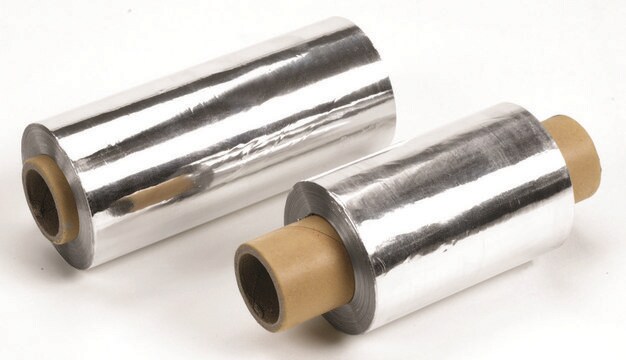266957
Aluminum
foil, thickness 1.0 mm, 99.999% trace metals basis
About This Item
Prodotti consigliati
Livello qualitativo
Saggio
99.999% trace metals basis
Stato
foil
Temp. autoaccensione
1400 °F
Resistività
2.6548 μΩ-cm
Spessore
1.0 mm
P. ebollizione
2460 °C (lit.)
Punto di fusione
660.37 °C (lit.)
Densità
2.7 g/mL at 25 °C (lit.)
applicazioni
battery manufacturing
Stringa SMILE
[Al]
InChI
1S/Al
XAGFODPZIPBFFR-UHFFFAOYSA-N
Categorie correlate
Quantità
Codice della classe di stoccaggio
11 - Combustible Solids
Classe di pericolosità dell'acqua (WGK)
WGK 3
Punto d’infiammabilità (°F)
Not applicable
Punto d’infiammabilità (°C)
Not applicable
Dispositivi di protezione individuale
Eyeshields, Gloves, type N95 (US)
Scegli una delle versioni più recenti:
Possiedi già questo prodotto?
I documenti relativi ai prodotti acquistati recentemente sono disponibili nell’Archivio dei documenti.
I clienti hanno visto anche
Articoli
In many technologies, performance requirements drive device dimensions below the scale of electron mean free paths (λe). This trend has increased scientific interest and technological importance of electrical resistivities at the nanoscale.
Can there be an effective strategy for finding breakthrough materials, since they are, by definition, unpredictable? One answer is found in Combinatorial Materials Science techniques, which represent a powerful approach to identifying new and unexpected materials.
Biomedical implants are essentially foreign substances within the human body that must survive many years’ exposure to demanding mechanical and physiological conditions. Despite these challenges, metal implants have been widely used to substitute for or rebuild hard tissues such as bones and teeth.
The unique properties of the rare-earth elements and their alloys have brought them from relative obscurity to high profile use in common hightech applications.
Global Trade Item Number
| SKU | GTIN |
|---|---|
| 266957-6.8G | |
| 266957-1EA | 4061826705131 |
| 266957-27.2G |
Il team dei nostri ricercatori vanta grande esperienza in tutte le aree della ricerca quali Life Science, scienza dei materiali, sintesi chimica, cromatografia, discipline analitiche, ecc..
Contatta l'Assistenza Tecnica.


